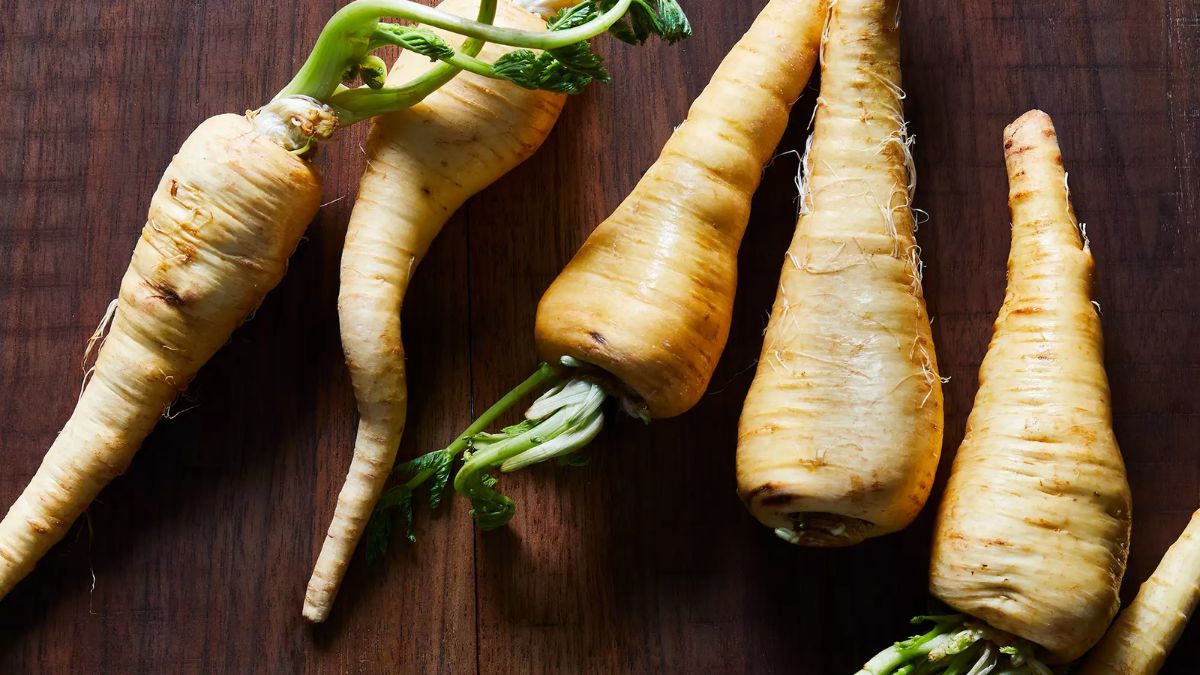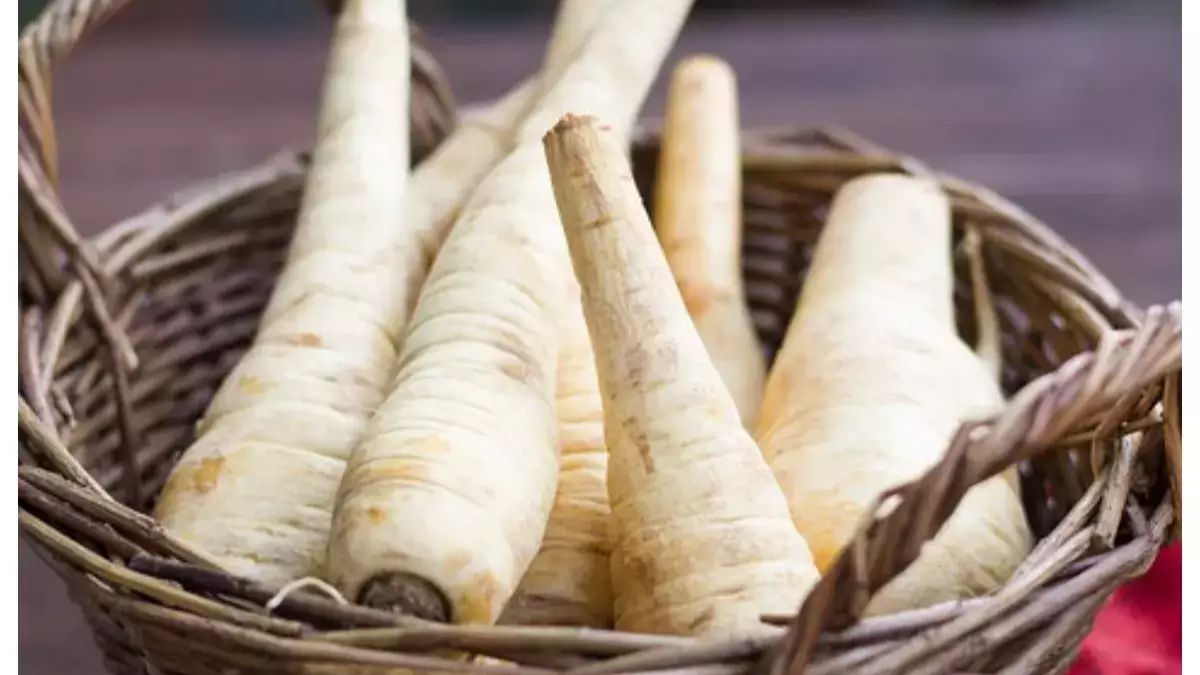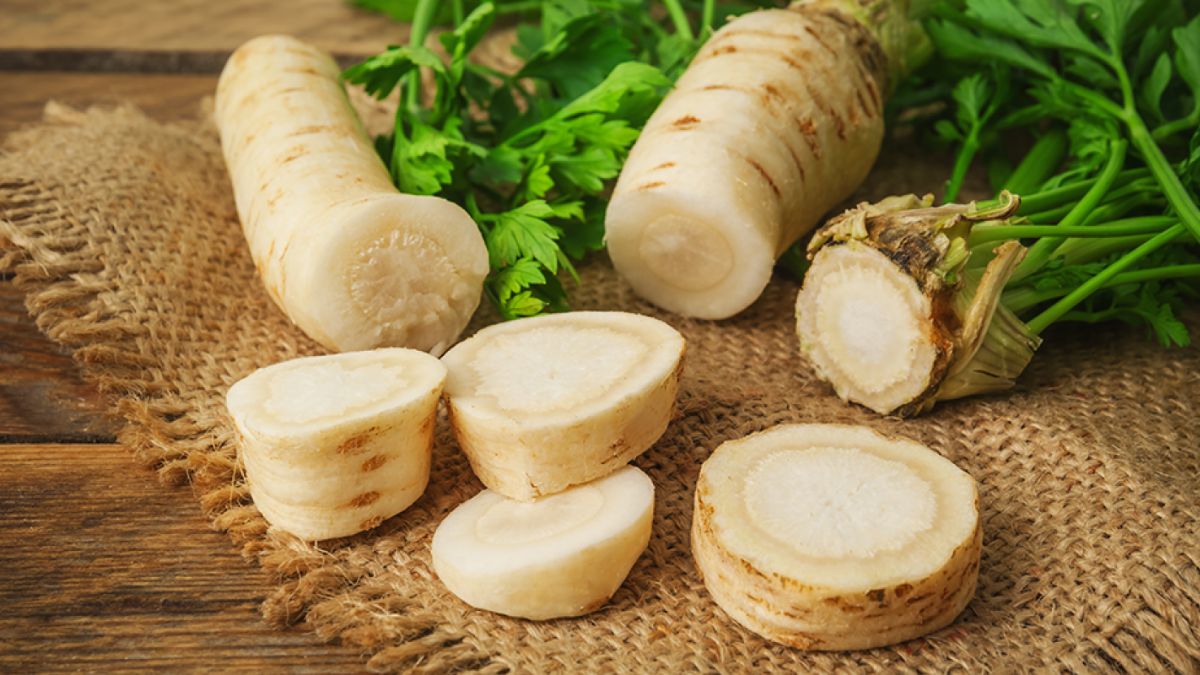The parsnip has been around for thousands of years. Before potatoes took over as the main starch, parsnips were the star of dinner tables during the winter months. You can enjoy parsnips’ sweet, nutty flavor throughout the coldest parts of the year with a few tips on selecting them. The root vegetable looks like a white carrot, and you can store them for several months under ideal conditions. If you want to know how to Select and Store Parsnips, you will get all the crucial information about storage in this article.
The parsnip is from Eurasia and has been growing since Roman times. People sometimes mistake this vegetable for a white carrot because it looks and feels the same but has a different taste. Parsnips are a popular cold-weather vegetable in some parts of Europe and the United States, and they are picked in the fall and winter. People in Britain often think of them as an important part of a Sunday roast.
What are Parsnips?
Parsnips are root vegetables that look like cream-colored carrots and are in the same family as parsley. You can eat them raw, but most people roast, boil, fry, or steam them. Parsnips have a thin, tan peel that is usually taken off before eating to reveal white flesh. They are priced about average and are generally cheaper in season.
Parsnips are a type of root vegetable related to carrots and parsley. They all come from the same family, Apiaceae. Its skin and flesh are cream-colored and have a long, tapered taproot like a carrot. Like carrots, they can be cooked in many different ways, but roasting makes them the sweetest.
Parsnips are from Eurasia, and the Romans were the first to grow them. They are picked like many root vegetables, from fall to spring. Those selected in the spring tend to be the sweetest because, while they were sleeping through the winter, the starches in their bodies turned into sugars.
How to Select and Store Parsnips?
Selecting Parsnips:
Even though most stores sell parsnips all year, the best time to buy them is in the fall and winter, when the cold and frost bring out their sweetness. It’s best to choose parsnips that are between 5 and 10 inches long.
The roots of these plants can get very big. But it’s best to avoid the big ones because they get a bitter, woody center you don’t want. The tips should be firm and sharp. Avoid ones that are soft or have lost their shape.
Look for firm meat with no weak spots, cuts, or cracks. The color should be a uniform yellow cream, with no dark spots that could be signs of rot or freeze-burn. If you buy parsnips with the greens still attached, the gardens should look fresh and not wilted.
Storing Parsnips:
Before storing, take the parsnip greens off and throw them away. Parsnips that haven’t been washed should be kept in a cool, dark place like carrots. The best site is a root cellar, but a basement or garage will also work. Keep them away from sources of heat. The best conditions are between 32°F and 40°F and 90% humidity.
Apples and pears can also give off a gas that makes parsnips taste bitter, so don’t store them near parsnips. Under these conditions, parsnips should last for four to six months. It’s a good idea to check on them often and take out any roots that are getting weak.
To freeze parsnips, cut them into 1/2-inch cubes and boil or steam them for 3–5 minutes. You can also wrap parsnips in a paper towel and put them in a plastic bag before putting them in the vegetable drawer of your fridge. If you do it this way, they should last at least two weeks. Cooked parsnips can be stored in the refrigerator for up to three days in an airtight container.
Once the parsnips are cool, please put them in containers with tight lids and freeze them for eight to ten months. Parsnip purée that has been fully cooked can also be frozen for up to eight months. If you add other things to your parsnip purée, especially dairy, you shouldn’t freeze it for more than one month.
Handling Homegrown Parsnips
If you grow and store your parsnips, remember that touching the plant can cause severe reactions like skin sores and dermatitis. It is more common with wild parsnip, which grows along roads and is caused by sunlight.
Sensitive people may also react when they touch the sap of cultivated parsnip leaves. 1 To avoid this painful situation, work with parsnips in your garden on cloudy days while wearing long sleeves, pants, and gloves. If the reaction is bad, you should see a doctor.
How to Cook with Parsnips?
Be sure to wear gloves when you pick parsnips from your garden. When the sun is out, the leaves of the parsnip plant can make your skin itch, and the rash that comes from it can sometimes stick around for months.
Before using them, scrub the parsnips well and cut off the stem end. You can eat them with or without the peel, but if you take the time to peel them with a vegetable peeler, they will be more tender and uniform in texture.
The peel can also give the fruit a bitter taste that some people may not like. Parsnips that are older and bigger will have a woody center. The best way to deal with this is to cut parsnips in half lengthwise and then cut out and throw away the core, which is darker than the rest of the vegetables and easy to spot.
Younger parsnips peeled and trimmed can be used whole or chopped. Roasting is one of the best ways to enjoy them, but you can also cook them on the stovetop or grill.
Note that cut parsnips turn brown in the air like an apple. If you’re not going to use the cut parsnips right away, you can lessen the effect by putting them in a water bowl with fresh lemon juice. The vegetable can also be fried or baked as an alternative to french fries and potato chips.
What do Parsnips Taste Like?
A parsnip is a long root vegetable with a pointy end. Parsnips have a taste all their own. They are sweet like a carrot but also taste earthy and nutty. When cooked, they are even more precious than carrots. Before sugar cane was widely available, Europeans used parsnips to make sugar.
The sweet, mild taste of the root vegetable makes it a welcome addition to many dishes. In this way, it looks like a carrot, and they are in the same family. But parsnips don’t taste like carrots all that much. They are sweeter, like sweet potatoes, and have a delicious nutty or earthy flavor from how nature made them.
How adorable are parsnips, then? Before sugarcane was widely available, Europeans used parsnip as a sweetener. It tastes sweet and nutty, with some peppery and earthy notes. When cooked, it tastes even more precious.
Parsnips vs. Turnips vs. Carrots
It turns out that people have been confused about the difference between parsnips and carrots for thousands of years. People think that the Romans were the first to grow parsnips, but they were called carrots back then, so it’s unclear where they came from.
Parsnips and carrots are in the same family, but their tastes differ. The taste of parsnips is sweeter and more like licorice, with a hint of spice, and this is different from carrots’ sweetness, which tastes like winter squash.
Turnips are another root vegetable that people often compare to parsnips, but they come from different families. Turnips are in the same family as cabbage and mustard greens, and this family is called Brassicaceae. They have a pinkish-purple crown and are much more round and fat.
As far as vitamins and minerals go, parsnips have more than turnips. Regarding taste, turnips are more bitter and spicy than sweeter parsnips. But parsnips have a glycemic index that is not as high. Turnips, on the other hand, are low in calories, fiber, and antioxidants and high in glucosinolates and Vitamin C.
Where to Buy Parsnips?
Parsnips are sometimes sold all year long in grocery stores, but they are more common in the fall and winter. Find them near the carrots that have had the green tops cut off. Most of the time, parsnips are sold by the pound, but sometimes you can find them in plastic bags like carrots.
Parsnips are easy to grow at home and do their best in cool weather. During cold months, they are especially fresh at the farmer’s market. Look for very firm and smooth parsnips with no dark or soft spots. The point should be sharp and strong, not skinny.
Parsnips of Pastinaca sativa are in the same family as parsley (Apiaceae). They have grown since ancient times for their large, tapering, white, fleshy roots, which can be eaten with a unique flavor. They need to grow for a few months before they are ready to be picked, and they can be harvested all winter long if left in the ground. The source can be found on roads and open areas in Great Britain, Europe, and temperate Asia.
Are Parsnips Good for Weight Loss?
Parsnips are great for a healthy weight-loss diet because they are low in calories and fiber. Parsnips are soft in calories and have a lot of water and fiber, two things that may help you lose weight.
Fiber moves slowly through your digestive system, making you feel fuller for longer. This may make you less hungry and cut down on how much you eat. One study found that adding 14 grams of fiber to your daily diet could cut your calorie intake by up to 10%, which could help you lose 4 pounds (1.9 kg) in four months.
Studies show that eating more foods with a lot of water may be linked to eating fewer calories and losing weight. One cup of parsnips (133 grams) has only 100 calories but 6.5 grams of fiber. This root vegetable is also very wet, with about 79.5 percent water.
Conclusion
In this article, you have learned how to select and store parsnips. If you don’t have a root cellar, you can keep unwashed parsnips in the fridge for up to three weeks, loosely wrapped in a plastic bag. Since their shelf life can depend on how fresh they were when you bought them, check them often and plan to use them sooner.
Cooked parsnips can be kept in the fridge for up to three days in a container that holds air out, and you can also put them in the freezer for up to three months. You can usually find parsnips at grocery stores or farmer’s markets, especially in the fall and winter.
But if you don’t have any, you probably already know the best replacement: carrots. Even though they taste a little bit different, they are still related because they are the same size, shape, and texture and have a mild sweetness.


